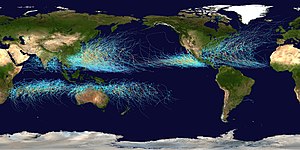메가크라이오메테오르
Megacryometeor| 다음에 대한 시리즈 일부 |
| 날씨 |
|---|
 |
| |
메가크라이미터는 큰 우박에서 검출된 많은 질감, 수화학 및 동위원소 특성을 공유함에도 불구하고 적운하구운 시나리오(즉, 맑은 하늘 조건)와 분명히 다른 비정상적인 대기 조건에서 형성되는 매우 큰 얼음 덩어리다. 그것들은 때때로 거대한 우박이라고 불리지만, 뇌우 상태에서는 형성될 필요가 없다. 지구과학연구소의 행성 지질학자 겸 우주생물학자 예수 마르티네스 프리아스(스페인어: Instituto de Geociencias, IGEO) in the Spanish National Research Council (Spanish: Consejo Superior de Investigaciones Científicas, CSIC)[1] in Madrid, pioneered research into megacryometeors in January 2000 after ice chunks weighing up to 6.6 pounds (3.0 kg) rained on Spain out of cloudless skies for ten days.
질량 및 크기
2000년 이후로 50 메가미터 이상이 기록되었다. 그것들은 0.5킬로그램에서 수십킬로그램 사이의 질량이 다양하다. 브라질의 한 곳은 무게가 50kg(110lb)이 넘는다.[2] 1849년 8월 13일 스코틀랜드에서 약 2m(6피트 7인치) 크기의 청크가 떨어졌다.[3]
포메이션
메가크리미터(migacryometer)를 만드는 과정은, 주로 메가크리미터(migrateometer)를 생산하는 데 필요한 대기 역학에 관해서 완전히 이해되지 않는다. 그들은 우박의 생산으로 이어지는 것과 유사한 형성 메커니즘을 가지고 있을지도 모른다.[4] 과학적인 연구는 그들의 구성이 그들이 떨어지는 지역의 일반적인 대류권 빗물과 일치한다는 것을 보여준다. 또한 메가크리미터는 얼음과 수화학 및 동위원소 이질성의 질적 변화를 나타내는데, 이는 대기 중에 복잡한 형성 과정을 나타낸다.[5][6][7] 간혹 여객기에서 떨어지는 큰 얼음 덩어리가 사용된 소독제 때문에 뚜렷이 파란색을 띠기 때문에(그들의 공통 명칭인 '블루아이스'를 붙여서) 비행기 화장실 누수로부터 형성되지 않는 것으로 알려져 있다.
일부 사람들은 이 얼음 덩어리가 정상적인 대기 조건을 통해 이 항공기들에 축적된 일반 물 얼음이 쉽게 풀린 후 항공기 동체로부터[4] 떨어졌을 것이라고 추측했다. 그러나 유사한 사건이 항공기의 발명 이전에 일어났다.[8][9] 연구에 따르면 대류권의 변동은 성층권 하층 및 성층권 냉각의 수화 작용과 관련이 있다.[5] 자세한 마이크로 라만 분광학 연구는 메가크리미터 형성을 -10 ~ -20 °C(14 ~ -4 °F)의 특정 온도 범위 내에 배치할 수 있도록 했다.[10] 그들은 작은 충격 분화구를 남길 수 있기 때문에 가끔 유성과 혼동된다.
참조
- ^ "Ficha de Jesús Martínez Frías en el Directorio del IGEO de CSIC, 30 de enero de 2021".
- ^ Gelo kaindo do céu assusta moradores 2007-09-27 웨이백 머신에 보관(포르투갈어).
- ^ Peter T. Bobrowsky; Hans Rickman (2007). Comet/asteroid impacts and human society: an interdisciplinary approach. Springer. pp. 343–. ISBN 978-3-540-32709-7. Retrieved 2 February 2012.
- ^ a b Alan Bellows에 의한 메가크리미터의 특이현상
- ^ a b Martinez-FrÍas, J.; Delgado, A.; MillÁn, M.; Reyes, E.; Rull, F.; Travis, D.; Garcia, R.; LÓpez-Vera, F.; et al. (2005). "Oxygen and Hydrogen Isotopic Signatures of Large Atmospheric Ice Conglomerations". Journal of Atmospheric Chemistry. 52 (2): 185. Bibcode:2005JAtC...52..185M. doi:10.1007/s10874-005-2007-7.
- ^ Martinez-Frias, Jesus; Delgado Huertas, Antonio (2006). "Megacryometeors: Distribution on Earth and Current Research". AMBIO: A Journal of the Human Environment. 35 (6): 314. doi:10.1579/06-S-187.1. hdl:10261/36014.
- ^ Orellana, Francisco Alamilla; Alegre, José Ma Ramiro; Cordero Pérez, José Carlos; Martín Redondo, Ma Paz; Delgado Huertas, Antonio; Fernández Sampedro, Ma Teresa; Menor-Salván, César; Ruiz-Bermejo, Marta; et al. (2008). "Monitoring the fall of large atmospheric ice conglomerations: a multianalytical approach to the study of the Mejorada del Campo megacryometeor" (PDF). Journal of Environmental Monitoring. 10 (4): 570–4. doi:10.1039/b718785h. hdl:10261/36027. PMID 18385879.
- ^ William R. Corliss (1983). Tornados, dark days, anomalous precipitation, and related weather phenomena: a catalog of geophysical anomalies. Sourcebook Project. ISBN 978-0-915554-10-2.
- ^ Riesgos Naturales, Olcina Santos, J., Ayala-Carcedo, J.
- ^ Rull, F.; Delgado, A.; Martinez-Frias, J. (2010). "Micro-Raman spectroscopic study of extremely large atmospheric ice conglomerations (megacryometeors)". Philosophical Transactions of the Royal Society A: Mathematical, Physical and Engineering Sciences. 368 (1922): 3145–52. Bibcode:2010RSPTA.368.3145R. doi:10.1098/rsta.2010.0103. PMID 20529951.
외부 링크
| 무료 사전인 위키트리노리에서 메가크리메터를 찾아보십시오. |